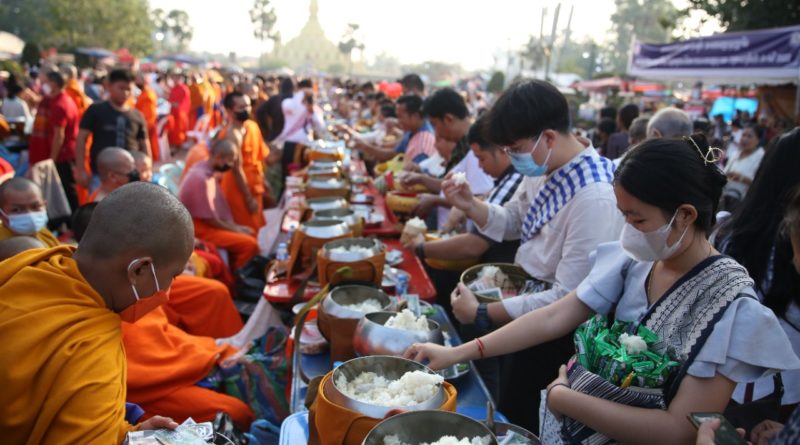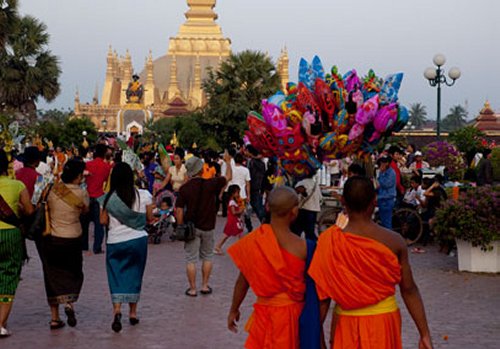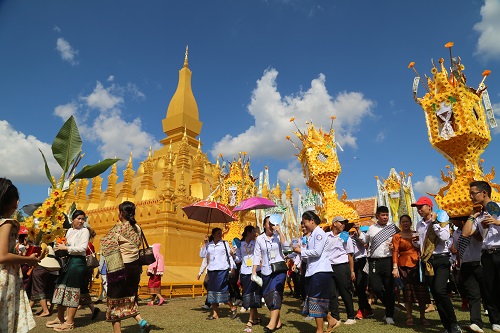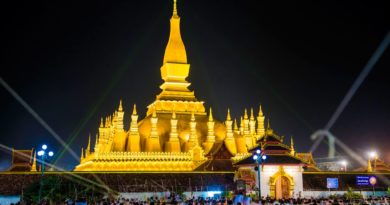That Luang Festival Honours Vientiane’s Grand Stupa
Source: Vientiane Times
People come from all over Laos and from other countries to attend the annual That Luang festival in Vientiane and pay homage to the That Luang, also known as the Grand Stupa, with Buddhists hoping to attend the event at least once in their lifetime.
The festival is spread over several days and always ends on the day of the full moon in the 11th lunar month, and this year took place from November 4-8.
The That Luang festival is one of biggest and most colourful celebrations in Laos and people nationwide look forward to this joyful and meaningful occasion. This year, the festival was particularly colourful, with a strong focus on Laos’ traditions and customs.
The stupa was built to house some bones that were believed to be those of Lord Buddha. The original stupa was very small and made of stone and was built as a place for people to worship and pray to Buddha.
The original structure was renovated on the orders of King Xaysetthathirath when he moved the Lao capital from Luang Prabang to Vientiane in 1560.
The king led his citizens in enlarging the stupa in 1566 and the original structure was covered with a bigger stupa. From then on the monument was named That Luang.

It has long been the national symbol of Laos and is one of the most important monuments in the country.
That Luang is a towering golden stupa and one of the biggest landmarks in Laos. It features typical Lao motifs and is among the oldest structures in Vientiane and the country, although it has been rebuilt several times.
When the annual festival arrives, residents from all over the country come to pay their respects and to earn merit through their actions.
An elderly resident of Vientiane, named Oudom Souvannasinh, told Vientiane Times “Every year, people come to worship at the stupa because this is a sacred site and people believe the stupa is the home for the Buddha’s bones.”
Every November, the colourful That Luang festival is staged to celebrate the stupa, which is the most revered in Laos. People engage in traditional activities and ritual ceremonies, including the wax castle procession, almsgiving, a game of traditional Lao hockey (known locally as tikhy), and candlelit processions, to honour both the stupa and King Xaysetthathirath.
This year, the That Luang festival in Vientiane started from November 3 to 8 and the wax castle procession started at Simeuang temple in the afternoon on November 7. The temple is more than two kilometres from That Luang stupa.
Thousands of people decorated their colourful Phasatpheung or wax castles and joined a procession to pay homage to the That Luang stupa during an annual festival.
Wax castles have been a part of the Lao lifestyle for many years. People wear their best clothes for this procession and there is a parade of men and women dressed in traditional Lao costumes.
A wax castle is a little monument shaped like a house made from wood scraps or banana trunks and decorated with sculpted wax, candles, incense sticks, bank notes and flowers to resemble a castle.
Wax castle offerings for worshipping the stupa and at sacred sites is a tradition which has been transferred from generation to generation.
The wax castle procession starts from Simeuang temple and slowly moves to Nongbon Road. Residents from nine districts of Vientiane with their wax castles gather at Nongbon temple before the large parade moves towards That Luang stupa.
The large parade of colourful wax castles will be followed by thousands of people, and on the way there is also traditional music played with drums and Kong, singing and dancing.
A wax castle is considered a very worthy offering to the stupa, and a procession always walks three times around the ordinary hall of the temple as it is led by monks chanting prayers.
A fair is set up with numerous stalls selling local products such as clothing, silk garments, handicrafts, and agricultural produce from around the country.
On the morning of the last day of the festival thousands of people gather on the esplanade to give alms to a large assembly of monks.
As is the norm after the almsgiving ceremony, people tuck into a late breakfast when the aroma of all manner of ready-to-eat food, such as grilled chicken, sticky rice cooked in bamboo, meatballs and fried noodles permeates the air.
In the afternoon people watch a Lao-style hockey match on the esplanade, and in the evening thousands of people return to take part in a candlelight procession, walking around the stupa three times, while murmuring prayers to the Buddha and recollecting his teachings.
Then it’s time to watch a cultural performance and do some last minute shopping and snacking.
The stupa has long been considered the national symbol and is one of the most well-known attractions in Vientiane, thanks to its magnificent appearance.
That Luang has a long history and features some intricate architecture and carvings. Centrally located in That Luang village, Xaysettha district, it is easily reached on foot and can be viewed from afar, with its gleaming pinnacles rising into the blue sky.
The stupa is a striking structure and is about 45 metres high at its tallest point. The central spire is surrounded by 30 smaller spires, and the stupa itself is surrounded by a square formation of broad open pathways that are lined with small Buddha images.
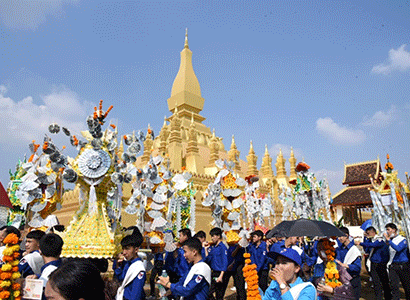 | 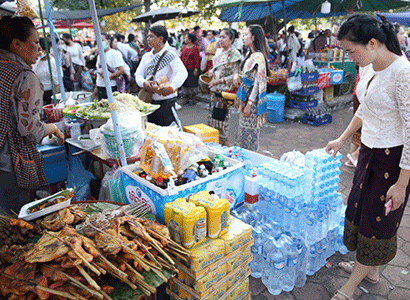 |
|---|---|
| People carry ornate wax pyramids around the stupa. –Photo Lao Security News | Selling food and beverages in That Luang festival. –Photo Sangkhomxay |

